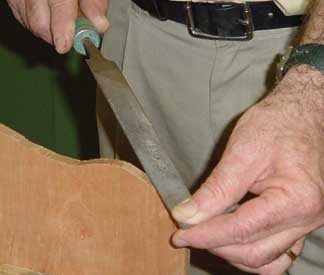Rasps and Files
 |
Rasps and files are hand tools that are used for smoothing and shaping
of metal and wood when other edge cutting tools won't do the trick.
Files are usually used on metal, while rasps are used for shaping and removal
of wood. Rasps and files come in various shapes, and the teeth range
from very coarse to very fine.
This sheet describes the proper use of rasps and files. For more help ask your instructor or refer to one of the many texts available. |
Controls: Rasps and files are simple hand tools, so they have no controls or settings.
Operation (Shaping): The shaping or removal of wood from stoke with a rasp is a common operation.
1. Before using, make sure that the rasp has a handle covering
the tang.
2. Secure your material with a vice or any other clamping device.
3. Make sure you select the correct type of rasp, and the right
coarseness of the teeth.
4. Hold the handle of the rasp in your right hand, and use your
left hand to direct and angle the point of the rasp.(See picture below)
5. To start shaping the wood, hold the rasp at an angle, and
apply pressure on the forward stroke as you ride the rasp across.
Lift slightly and return.
6. To shape a curved edge, use the round side of the rasp, and
twist slightly on the forward stroke.
7. Remember to use a file card to clean the teeth when they get
clogged.

Potential hazards: The biggest hazard when
using a rasp or file is the tang. The tang is the pointed tip in
the handle position. If you do not place a handle over the tang before
use, you have a good chance of puncturing your hand or any other part of
your body with it. Never use a rasp or file without a handle.
Safety practices: Because of potential hazards, the following safety rules must be followed.
- Be sure to perform only operations you know how to do safely.
- Always wear safety glasses.
- Never wear cloths or other articles that dangle.
- Be sure to have firm footing.
- Check the rasps and files to make sure they are in good working order.
- Check the stock for foreign objects.
- Avoid distractions.
- Do not allow others to crowd around you.
- Always cover the tang with a handle.
- Always have one hand on the handle, and one hand to angle and guide.
- Always secure your material in some way.
Hand, Jack. (1975). Modern Woodworking. Reston Publishing Company. Reston, Virginia.
Feirer, John L. I. A. Bench Woodwork. Chas. A. Bennett Co. Inc. Peoria, Illinois.
ITT 252 - Materials Processing
Department of Technology
University of Southern Maine
Prepared by Michael T. Shippee, 12/16/2002